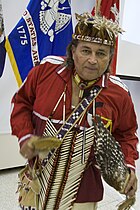| Named after | Nottoway people |
|---|---|
| Type | state-recognized tribe, nonprofit organization |
| EIN 34-2005753[1] | |
| Purpose | A23: Cultural, Ethnic Awareness[1] |
| Location | |
Chairman | Walter D. Brown[1] |
Revenue (2020) | $30,957[1] |
| Expenses (2020) | $12,815[1] |
| Funding | grants, contributions[1] |
Staff (2020) | 0[1] |
| Website | www |
The Cheroenhaka (Nottoway) Indian Tribe is a state-recognized tribe and nonprofit organization in Virginia.[2] The organization identifies as descending from Nottoway people. They are not federally recognized as a Native American tribe.[2]
The name Cheroenhaka is the autonym for Nottoway people.[3]
State-recognition
[edit]
The Commonwealth of Virginia recognized the Cheroenhaka (Nottoway) Indian Tribe as a tribe in 2010, when the state also recognized the Nottoway Indian Tribe of Virginia.[4]
Organization
[edit]The group formed Cheroenhaka (Nottoway) Indian Tribal Heritage Foundation, a 501(c)(3) nonprofit organization in 2005, with the mission to "Educational, charitable and religious. Educational, charitable, and religious."[1] In 2020, the nonprofit held $468,180 in assets and hiring no employees.[1]
The chief is Walter "Red Hawk" Brown of Courtland, Virginia.[5]
Notes
[edit]- ^ a b c d e f g h i j k "Cheroenhaka -nottoway- Indian Tribal Heritage Foundation". Cause IQ. Retrieved 8 April 2022.
- ^ a b "State Recognized Tribes". National Conference of State Legislatures. Archived from the original on 25 October 2022. Retrieved 7 April 2022.
- ^ Hodge, Frederick Webb (1912). Handbook of American Indians North of Mexico: N-Z. Washington, DC: Smithsonian Institution. p. 87.
- ^ "Virginia Indians". Secretary of the Commonwealth. Retrieved 8 April 2022.
- ^ "Tribal Directory". National Congress of American Indians. Retrieved 8 April 2022.
Well, that’s interesting to know that Psilotum nudum are known as whisk ferns. Psilotum nudum is the commoner species of the two. While the P. flaccidum is a rare species and is found in the tropical islands. Both the species are usually epiphytic in habit and grow upon tree ferns. These species may also be terrestrial and grow in humus or in the crevices of the rocks.
View the detailed Guide of Psilotum nudum: Detailed Study Of Psilotum Nudum (Whisk Fern), Classification, Anatomy, Reproduction